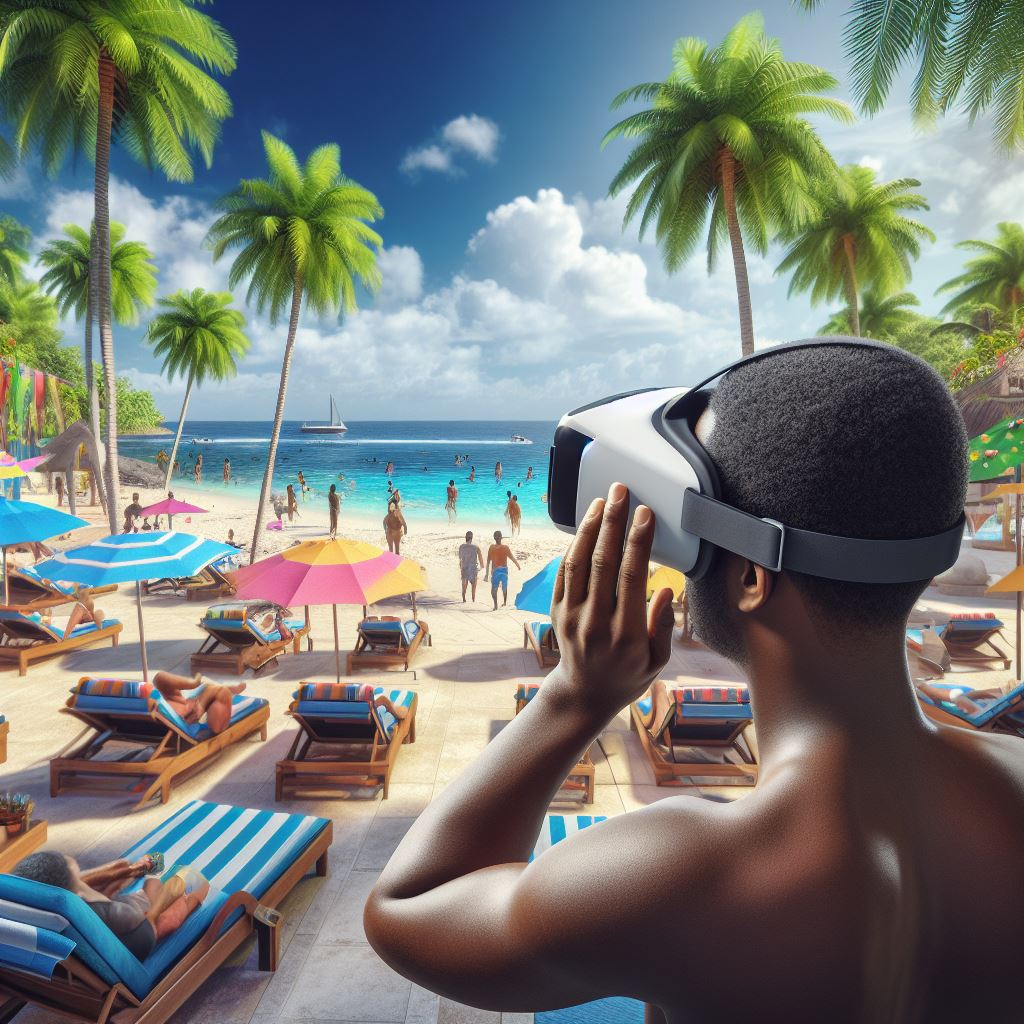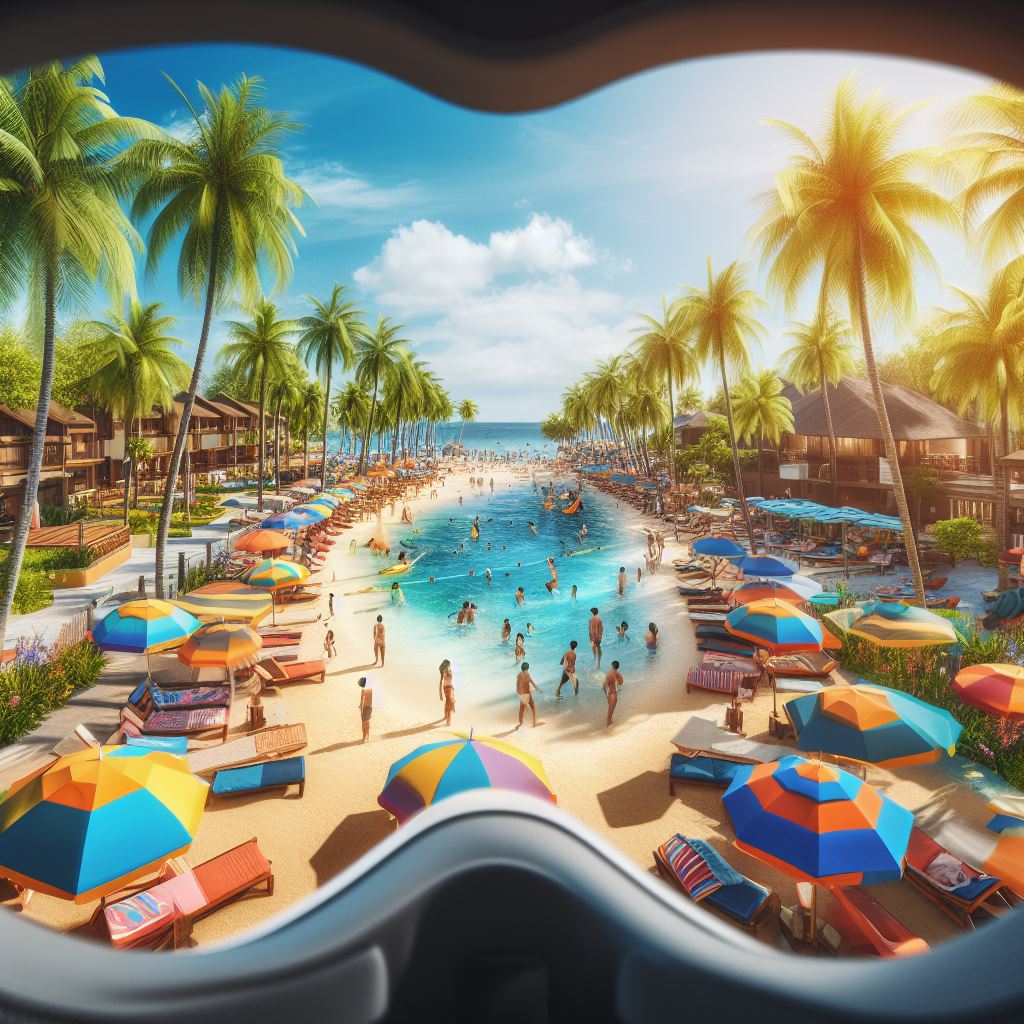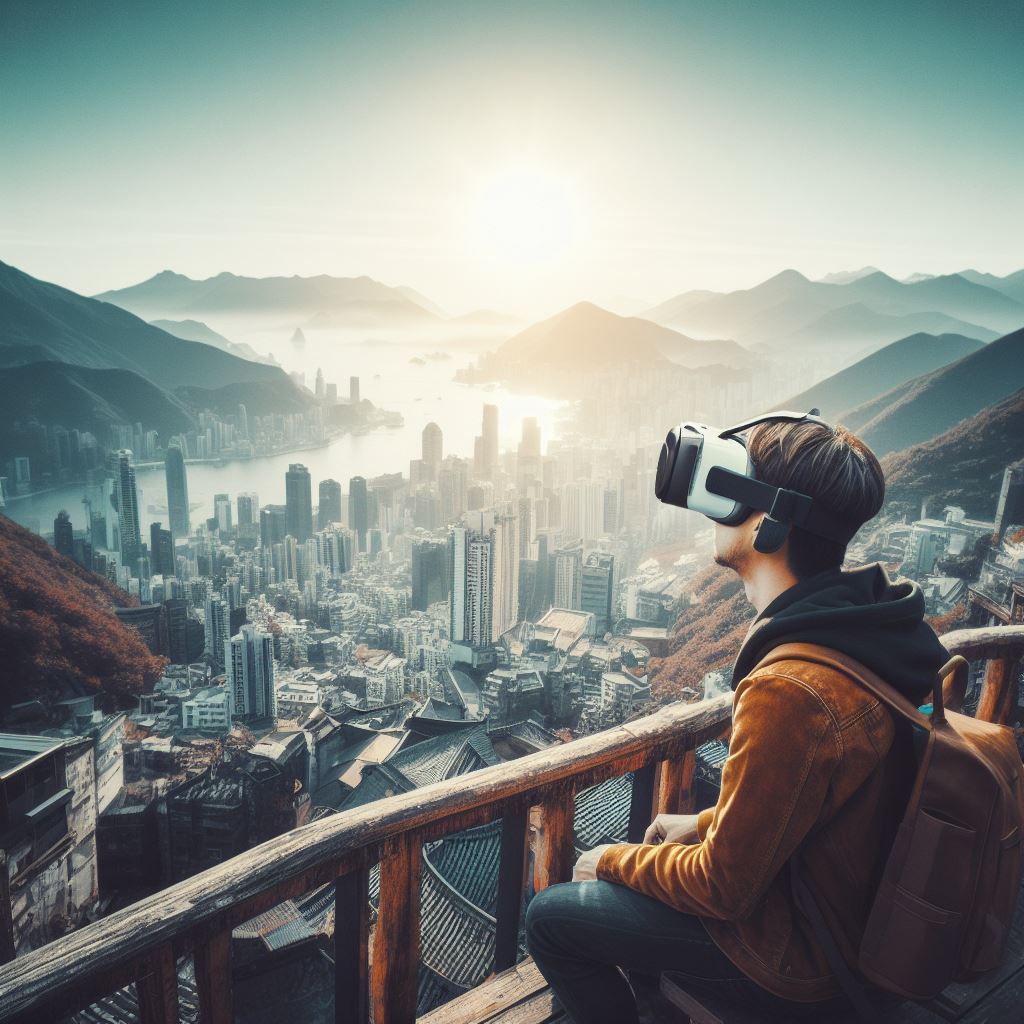Subscribe now for hand-picked best experiences, product discounts, and the latest VR trends, tips and tricks, straight to your inbox.
Key Takeaways
- VR tourism is the use of virtual reality technology to experience different places and cultures without leaving your home.
- VR tourism can offer many benefits, such as convenience, affordability, accessibility, education, and entertainment.
- It can also have some drawbacks, such as technical issues, lack of realism, ethical concerns, and social isolation.
- There are many types of VR tourism experiences, such as educational, cultural, historical, natural, adventure, space, and social VR tours.
- To use VR for tourism, you need a VR device, such as a headset, a smartphone, or an arcade, and a VR app that offers the content you want to explore.
- VR traveling is a growing trend that is expected to become more immersive, mobile, and eco-friendly in the future.
Introduction
Have you ever wanted to visit the Eiffel Tower, the Great Wall of China, or the Pyramids of Giza, but couldn’t afford the time or money to travel? Or maybe you have a bucket list of destinations that are too far, too dangerous, or too inaccessible to reach in real life? Or perhaps you are just curious about different cultures, histories, and natural wonders of the world, and want to learn more about them?
If you answered yes to any of these questions, then you might be interested in Tourism in VR. VR tourism is the use of virtual reality technology to experience different places and cultures without leaving your home. VR traveling can offer you a way to satisfy your wanderlust, broaden your horizons, and have fun, all from the comfort of your couch.
But what exactly is VR tourism, and how does it work? What are the benefits and drawbacks of VR traveling? What are the different types of VR tourism experiences, and how can you use VR for tourism? And what are the trends and predictions for the future of VR tourism?
In this article, we will answer these questions and more, and provide you with a comprehensive guide to VR tourism. Whether you are a seasoned traveler, a novice explorer, or a VR enthusiast, you will find something useful and interesting in this article. So, let’s get started!
What is VR tourism?
VR tourism is the use of virtual reality technology to experience different places and cultures without leaving your home. Virtual reality (VR) is a computer-generated simulation of a three-dimensional environment that you can interact with using a VR device, such as a headset, a controller, or a glove. VR can create a sense of presence, immersion, and realism, making you feel like you are actually in the virtual world.
VR tourism uses VR to create virtual representations of real or fictional destinations, and allows you to explore them as if you were there. You can see, hear, and sometimes even touch and smell the virtual environment, and interact with the objects and characters in it. You can also choose your own path, pace, and perspective, and customize your experience according to your preferences and interests.
VR tourism can be used for various purposes, such as:
- Convenience: VR tourism can save you the hassle and cost of traveling, and allow you to visit places that are otherwise difficult or impossible to reach in real life. You can travel anytime, anywhere, and as often as you want, without worrying about visas, flights, hotels, or weather.
- Affordability: VR tourism can be much cheaper than real travel, especially if you use a VR-enabled smartphone or a low-cost headset. You can also avoid the hidden costs of travel, such as transportation, food, souvenirs, or taxes.
- Accessibility: VR tourism can make travel more accessible and inclusive for people who have physical, mental, or financial limitations that prevent them from traveling in real life. You can also visit places that are restricted, endangered, or extinct, such as ancient ruins, war zones, or extinct animals.
- Education: VR tourism can provide you with a rich and engaging learning experience, and help you gain knowledge and skills that are relevant to the destination. You can also learn about the history, culture, and language of the place, and interact with the locals and experts.
- Entertainment: VR tourism can offer you a fun and exciting way to spend your leisure time, and provide you with a variety of options to suit your mood and taste. You can also enjoy the thrill and challenge of VR games, puzzles, and quests, and earn rewards and achievements.
What are the drawbacks of VR tourism?
While VR tourism can offer many benefits, it can also have some drawbacks, such as:
- Technical issues: VR tourism can be affected by the quality and availability of the VR technology, such as the resolution, latency, battery life, and compatibility of the VR device, and the bandwidth, speed, and security of the internet connection. Technical issues can cause glitches, errors, or crashes, and ruin your VR experience.
- Lack of realism: VR tourism can never fully replicate the real world, and may lack some of the sensory, emotional, and social aspects of real travel. For example, you may not be able to feel the temperature, humidity, or wind of the destination, or the physical contact with the people or objects in it. You may also not be able to experience the spontaneity, serendipity, or surprise of real travel, or the authentic and meaningful interactions with the locals and other travelers.
- Ethical concerns: VR tourism can raise some ethical questions, such as the ownership, privacy, and consent of the VR content, and the impact of VR tourism on the real destination and its people. For example, who owns the rights to the VR representation of a place or a culture, and how can they be protected from misuse or abuse? How can the personal data and preferences of the VR users be collected and used without violating their privacy or security? How can the VR users be informed and educated about the cultural and environmental sensitivity of the destination, and avoid stereotyping, misrepresenting, or exploiting it?
- Social isolation: VR tourism can make you feel isolated from the real world, and reduce your social skills and relationships. For example, you may spend too much time in VR, and neglect your responsibilities, hobbies, or health in real life. You may also lose touch with your friends and family, and prefer the virtual interactions over the real ones. You may also develop a distorted sense of reality, and have difficulty adjusting to the real world after leaving VR.
Types of VR tourism experiences
There are many types of VR tourism experiences, depending on the theme, content, and format of the VR tour. Here are some of the most common and popular types of VR tourism experiences:
- Educational VR tours: These are VR tours that focus on teaching you something about the destination, such as its geography, history, culture, or language. For example, you can learn about the solar system by visiting different planets, or about the ancient civilizations by visiting their monuments and artifacts. Educational VR tours can be interactive, immersive, and gamified, and can provide you with feedback, quizzes, and rewards.
- Cultural VR tours: These are VR tours that focus on exposing you to the culture and lifestyle of the destination, such as its art, music, cuisine, or festivals. For example, you can explore the museums and galleries of Paris, or enjoy the carnival and samba of Rio de Janeiro. Cultural VR tours can be colorful, vibrant, and expressive, and can provide you with audio, visual, and sometimes even olfactory stimuli.
- Historical VR tours: These are VR tours that focus on recreating the past events and scenarios of the destination, such as its wars, revolutions, or inventions. For example, you can witness the American Civil War, or the French Revolution, or the Industrial Revolution. Historical VR tours can be realistic, dramatic, and emotional, and can provide you with narration, dialogue, and sometimes even role-playing opportunities.
- Natural wonders VR tours: These are VR tours that focus on showcasing the natural beauty and diversity of the destination, such as its landscapes, wildlife, or climate. For example, you can admire the Grand Canyon, or the Great Barrier Reef, or the Northern Lights. Natural wonders VR tours can be breathtaking, awe-inspiring, and relaxing, and can provide you with panoramic, 360-degree, and sometimes even 3D views.
- Adventure VR tours: These are VR tours that focus on providing you with thrill and excitement, and challenging you to overcome your fears and limits. For example, you can skydive, or bungee jump, or surf. Adventure VR tours can be exhilarating, adrenaline-pumping, and fun, and can provide you with motion, vibration, and sometimes even haptic feedback.
- Space VR tours: These are VR tours that focus on taking you to the outer space, and exploring the unknown and the infinite. For example, you can visit the moon, or Mars, or the International Space Station. Space VR tours can be futuristic, imaginative, and mind-blowing, and can provide you with zero-gravity, anti-gravity, and sometimes even intergalactic experiences.
- Social VR experiences: These are VR experiences that focus on connecting you with other VR users, and creating a sense of community and belonging. For example, you can chat, play, or collaborate with other VR users from around the world, or join a VR club, group, or event. Social VR experiences can be friendly, interactive, and fun, and can provide you with avatars, emojis, and sometimes even voice and video communication.

How to use VR for tourism
To use VR for tourism, you need two main components: a VR device and a VR app.
A VR device is a hardware that enables you to access and interact with the VR content. There are different types of VR devices, such as:
- VR headsets: These are devices that you wear on your head, and that cover your eyes and ears. They provide you with a stereoscopic, immersive, and high-quality VR experience. Some examples of VR headsets are Oculus Quest 3, HTC Vive Pro 2, and PlayStation VR2
- VR-enabled smartphones: These are devices that you can use to view VR content on your phone screen, and that you can insert into a cardboard or plastic holder that you wear on your head. They provide you with a simple, affordable, and mobile VR experience. Some examples of VR-enabled smartphone devices are Google Cardboard, Google Daydream, and Samsung Gear VR.
- VR arcades: These are places that you can visit to use VR devices and content that are provided by the arcade. They provide you with a social, interactive, and diverse VR experience. Some examples of VR arcades are The Void, Sandbox VR, and Zero Latency.
A VR app is a software that provides you with the VR content that you want to explore. There are different types of VR apps, such as:
- VR tourism apps: These are apps that offer you VR tours of various destinations, such as cities, countries, or landmarks. They provide you with information, narration, and sometimes even interaction with the VR environment. Some examples of VR tourism apps are Google Earth VR, Discovery VR, and Ascape VR.
- VR games: These are apps that offer you VR games that are related to tourism, such as puzzles, quests, or adventures. They provide you with fun, challenge, and sometimes even rewards and achievements. Some examples of VR games are The Lab, Everest VR, and Robinson: The Journey.
- VR social apps: These are apps that offer you VR social experiences that are related to tourism, such as chatting, playing, or collaborating with other VR users. They provide you with community, friendship, and sometimes even romance. Some examples of VR social apps are AltspaceVR, VRChat, and Facebook Spaces.
To use VR for tourism, you need to choose a VR device and a VR app that suit your needs, preferences, and budget. You also need to follow some tips and precautions to ensure a safe and enjoyable VR experience, such as:
- Check the compatibility: Make sure that your VR device and app are compatible with each other, and that your VR device meets the minimum requirements for the VR app. You can check the compatibility and requirements on the websites or manuals of the VR device and app.
- Set up the space: Make sure that you have enough space and privacy to use your VR device and app, and that you remove any obstacles or distractions that may interfere with your VR experience. You can also use a mat, a chair, or a boundary system to help you stay in the safe zone.
- Adjust the settings: Make sure that you adjust the settings of your VR device and app, such as the brightness, volume, and comfort level, to suit your preferences and comfort. You can also use the tutorials, guides, or help menus of your VR device and app to learn how to use them properly.
- Take breaks: Make sure that you take breaks from your VR experience, and that you do not use VR for too long or too often. You can also monitor your physical and mental health, and stop using VR if you feel any discomfort, such as nausea, dizziness, headache, eye strain, or fatigue.

VR tourism trends and predictions
VR tourism is a growing trend that is expected to become more immersive, mobile, and eco-friendly in the future. Here are some of the trends and predictions for the future of VR tourism:
- The rise of mobile VR: Mobile VR is expected to become more popular and accessible, as more people own VR-enabled smartphones, and as more VR apps are developed for mobile platforms. Mobile VR can offer a convenient, affordable, and versatile VR experience, and can appeal to a wider and younger audience.
- The development of more immersive VR experiences: VR technology is expected to improve and innovate, and to provide more immersive and realistic VR experiences. For example, VR devices may become more lightweight, wireless, and comfortable, and may offer higher resolution, lower latency, and wider field of view. VR apps may also become more interactive, dynamic, and personalized, and may offer more sensory, emotional, and social stimuli.
- The use of VR for marketing and destination promotion: VR tourism can be used as a powerful tool for marketing and destination promotion, as it can showcase the attractions and features of a destination, and can influence the travel decisions and behaviors of potential travelers. VR tourism can also be used as a complementary or alternative way of experiencing a destination, and can enhance the satisfaction and loyalty of travelers.
- The potential of VR to reduce tourism’s environmental impact: VR tourism can be seen as a more sustainable and responsible form of tourism, as it can reduce the environmental impact of travel, such as carbon emissions, pollution, and waste. VR tourism can also raise awareness and appreciation of the natural and cultural heritage of a destination, and can encourage the conservation and preservation of it.
Conclusion
VR tourism is a new and exciting way of experiencing different places and cultures without leaving your home. VR tourism can offer you many benefits, such as convenience, affordability, accessibility, education, and entertainment. VR tourism can also have some drawbacks, such as technical issues, lack of realism, ethical concerns, and social isolation.
There are many types of VR tourism experiences, such as educational, cultural, historical, natural, adventure, space, and social VR tours. To use VR for tourism, you need a VR device, such as a headset, a smartphone, or an arcade, and a VR app that offers the content you want to explore.
VR tourism is a growing trend that is expected to become more immersive, mobile, and eco-friendly in the future.
If you are interested in VR tourism, and want to try it for yourself, here are some steps you can take:
- Research: Do some research on the VR devices and apps that are available and compatible, and that suit your needs, preferences, and budget. You can also read reviews, ratings, and recommendations from other VR users, and watch videos or demos of the VR experiences.
- Experiment: Try out different VR devices and apps, and see which ones you like and enjoy the most. You can also experiment with different types of VR tourism experiences, and see which ones you find the most interesting and engaging.
- Share: Share your VR tourism experiences with others, and invite them to join you in VR. You can also share your feedback, opinions, and suggestions with the VR developers and providers, and help them improve and innovate their VR products and services.
We hope that this article has given you a comprehensive guide to VR tourism, and that you have learned something new and useful from it. We also hope that you have found VR tourism to be a fascinating and fun way of traveling, and that you will continue to explore and enjoy it in the future.
Thank you for reading, and happy VR traveling! 🌎
Subscribe now for hand-picked best experiences, product discounts, and the latest VR trends, tips and tricks, straight to your inbox.



Leave a Reply